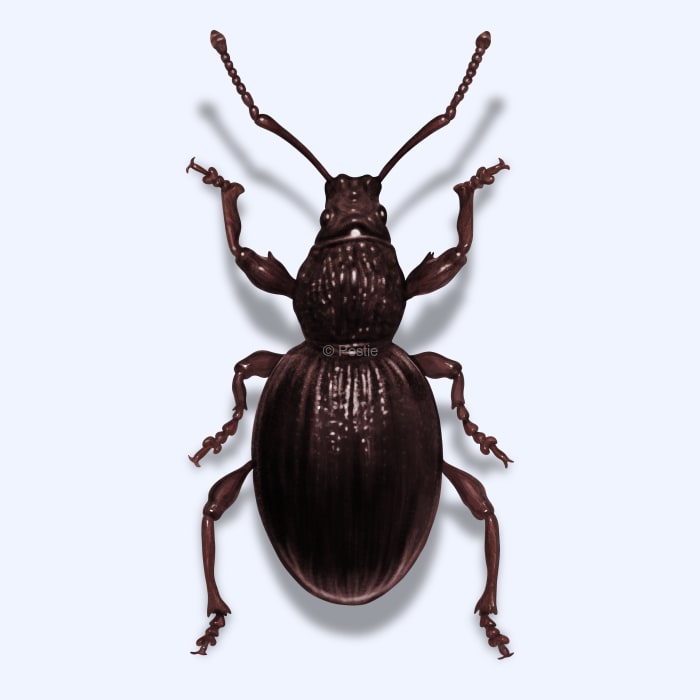How to identify and get rid of root weevils

Weevil, weevil, eat your roots!
Do you have mysterious holes in the leaves of your garden or ornamental plants, but you never can quite catch the culprit in the act? You may be dealing with the ultra-sneaky root weevils!
Root weevils are night-time nibblers, putting notches and holes in the leaves of your plants. It can often look like someone took a hole puncher to your plants in the middle of the night!
But they are far sneakier than that! Not only are the adults damaging the top half of the plant, but their larvae are probably chowing down on the bottom half of your plant underground!
Root weevil larvae feed on the roots of plants, causing them to wilt and yellow. Fortunately, severe dieback is rare for your landscape plants, but root weevils aren’t controlled; they can put pressure on your plants and stress them out.
How to identify root weevils
You can identify root weevils by looking for beetles with long snouts and pear-shaped bodies. Since they are nocturnal, you won’t be able to spot them during the day. Signs of their handiwork include leaves with notches along the margin. If you have plants that are wilting but won’t recover with watering or fertilizer, you might have damage in the roots. The larvae are small white grubs with orange head capsules.
How big are root weevils?
Root weevils grow to about 1/4 to 1/2 inch long as adults.
What other pests look like a root weevil?
Root weevils are very distinct in their appearance, but they some similar features to a bluegrass billbug.
Their damage to leaves can be confused with other insect damage, like Japanese beetles, sawflies, slugs, or leafcutter bee damage.
Where do root weevils live?
There are many species of root weevils that feed on over 100 different plants. Root weevils can be found throughout the United States in yards and gardens. Sometimes, they can wander inside the home by accident, but they don’t cause structural damage.
How to get rid of root weevils
Removing root weevils can be tricky since they only come out at night. If you notice a lot of damage on your favorite plants, you can use a sticky substance like Tanglefoot on a plant guard around the stem of plants. Since root weevils can only crawl and hide at the base of plants during the day, they will get stuck and die.
If root weevils manage to get inside your home, you can just vacuum them up and dispose of them away from your home. Sealing up cracks and gaps around doors and windows will help keep them from coming inside.
Additionally, you can use a spray around your home to prevent weevils from wandering inside. Check out Pestie’s DIY, pro-grade plan for affordable pest control that is customized to your location.
Treat root weevils with Pestie
If you're still having trouble keeping root weevils away, the best option is to use a pro-grade, effective pest control solution like Pestie.
Pestie is a do-it-yourself pest control solution that's specially designed to keep root weevils and other pests away from your home.
With Pestie, you can rest easy knowing that your living space is protected and free of creepy crawlies. And the best part? It's designed for people, pets, and the planet, so you can say goodbye to harsh chemicals and hello to peace of mind!
- Save hundreds compared to traditional annual pest plans
- People, pet, and planet-friendly
- Pro-grade customized formulas
Quick facts
- Scientific name
Includes Otiorhynchus Sulcatus, O. Meridionalis, O. Ovatus, O. Rugosostriatus
- Other common names
Strawberry Weevils, Lilac Root Weevils, Black Vine Weevils
- Colors
Black and gray
- Life span
2 years
- Diet
Leaves of ornamental and landscape plants
How dangerous are Root Weevils?
Low danger risk
Root weevils are not harmful to humans but can cause significant damage to gardens and indoor plants.
If you really want to find root weevils at the scene of the crime, use a red flashlight at night and shine the light on your plants. Most insects can’t see the color red and won’t run away from the light!








